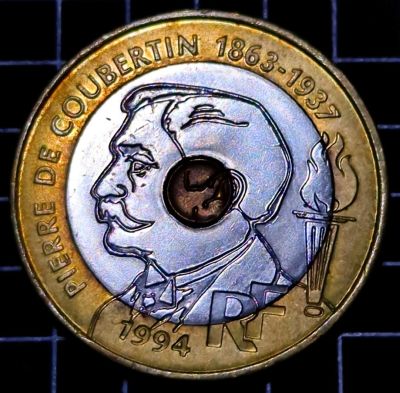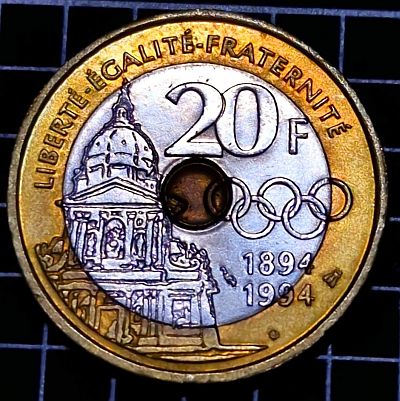A coin for the 100th Anniversary of the International Olympic Committee
The Olympics

(In 1913 Pierre de Coubertin designed the the Olympic rings: “five rings represent the five parts of the world now won over to Olympism” and the five colours of the rings plus the white background of the flag “combined to produce the colours of every country”. Drawing based on Pierre de Coubertin’s design Olympics.com)
The ancient Olympic Games were among the most important events in the Greek calendar. A cultural and religious festival, they took place every four years from 776 B.C. The ancient Olympic Games officially came to an end around 394 A.D., when Roman emperor Theodosius I outlawed pagan celebrations.
Nearly 1,500 years later, Pierre de Coubertin was a French educator and historian. At the 1889 Paris Universal Exposition, he organised the world’s first Congress on Physical Education. In 1894, in the grand amphitheatre of the Sorbonne University, 2,000 people rose in acclamation of his proposal to revive the Olympic Games. The first Olympic Congress was held that year, and the International Olympic Committee (IOC) was formed as the leader of the Olympic Movement and the guardian of the Olympic Games.
In 1896, the first celebration of the modern Olympic Games took place in its ancient birthplace – Greece. The Games attracted athletes from 14 nations, with the largest delegations coming from Greece, Germany, France and Great Britain.
Pierre de Coubertin is remembered today as the Father of the Modern Olympic Games.
Obverse

The obverse of the coin features a bust of Pierre de Coubertin’s left profile surrounded by the legend: “PIERRE DE COUBERTIN 1863-1937”. There is a torch carrying the Olympic flame and the monogram “RF”. Underneath is the year of issue: 1994.
RF stands for République française or “Republic of France”. The current French republic is known as the fifth republic. Since 1789 and the French Revolution, France has had 14 constitutions, including 5 republics:
- 1589-1789 Bourbon Monarchy (Ancien régime)
- 1789-1792 Revolution leading to constitutional monarchy
- 1792-1804 First Republic ‘Liberty, Equality, Fraternity’
- 1804-1814 First Empire: Napoleon Bonaparte, Emperor of the French
- 1814-1830 Bourbon Restoration: King Louis XVIII (1814-24), King Charles X (1824-30)
- 1830-1848 July Monarchy: King Louis-Philippe, Duke of Orleans
- 1848-1852 Second Republic: Louis-Napoleon Bonaparte, President
- 1852-1870 Second Empire: Napoleon III, Emperor of the French
- 1870-1940 Third Republic
- 1940-1944 The Vichy Regime (Etat français): Philippe Pétain, head of state
- 1944-1946 Provisional Government of the French Republic, headed by Charles de Gaulle
- 1946-1958 Fourth Republic
- 1958-present Fifth Republic
Reverse

The reverse features the Sorbonne, where the International Olympic Committee was founded in 1894. To the right is the face value, the five Olympic rings, and dates “1894 1994”. Around the edge is the motto of France: “FREEDOM – EQUALITY – FRATERNITY”
Either side of the dates are the privy of the Paris Mint (cornucopia), the engraver general Pierre Rodier (bee), and the workshop engraving coins and medals (foil AGMM).
This coin was the last 20 Francs coin issued by France. First issued in 1802, France issued 38 circulating coins of this value:
- Until 1914, 20 Francs coins were gold.
- The 1929-1939 issue was silver.
- The two issues from 1950 – 1954 were Copper-Aluminium.
- The 1992 – 2001 issue was Trimetallic: copper-aluminium-nickel core, nickel middle ring and copper-aluminium-nickel outer ring.
- In 1993 a commemorative issue of the same Trimetallic composition commemorated the Mediterranean Games.
- This 1994 issue (Same trimetallic composition) commemorating Pierre de Coubertin.
Interestingly, these last three 20 Francs coins make up three of the five circulating trimetallic coins ever issued. The other two are the 2017-18 Mauritania 20 Ouguiya, and the 1992-7 20 France from Monaco.
Back to the coin’s theme, and in 2013, France issued a 2 Euro coin commemorating the 150th anniversary of the birth of Pierre de Coubertin. In 2024, France issued a 2 Euro coin commemorating the 2024 Paris Olympics. A search for “Olympics” on Numista brings up 168 circulating coins. When adding in non-circulating coins, that number jumps to 1992, of which 39 have been issued by France. A search for “Olympic” in exonumia brings 741 results.
What is your favourite Olympic-themed numismatic piece? Let us know in the comments or on social media!


Leave a Reply